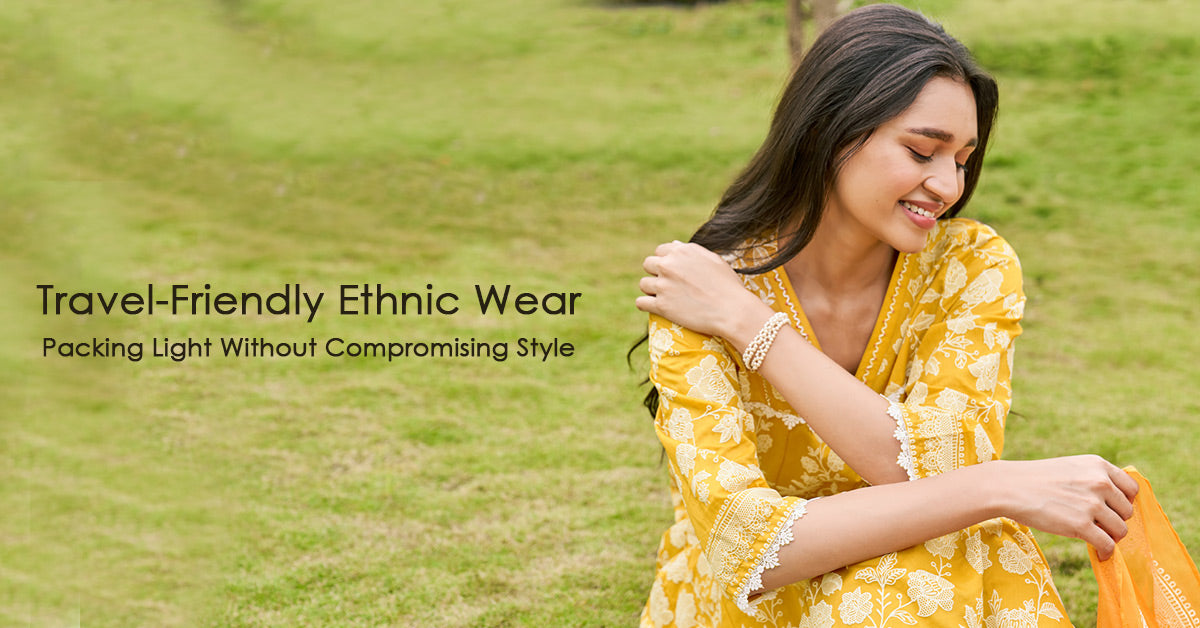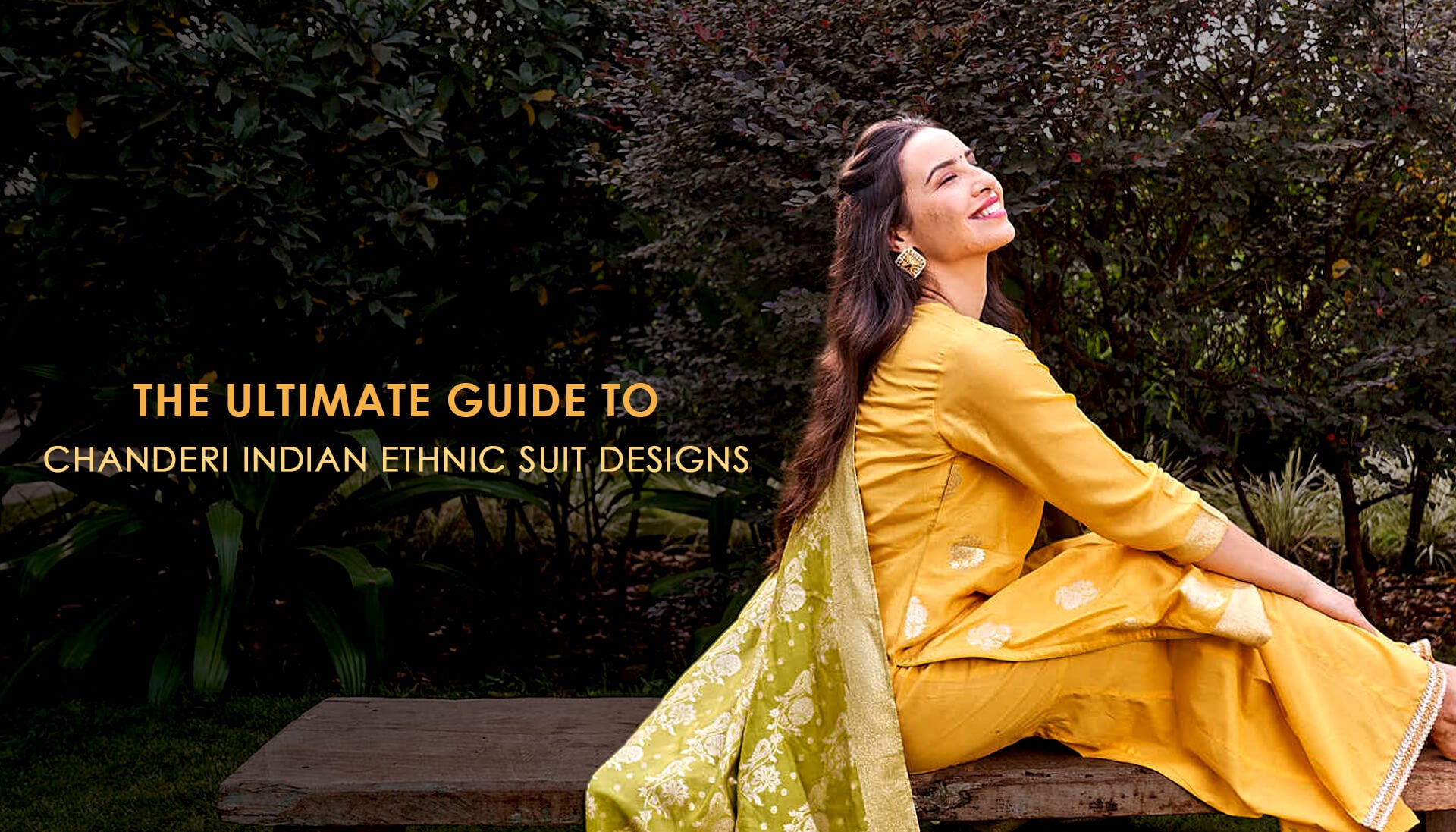Handloom And Handcrafted: The Beauty Of Artisanal Ethnic Wear
In a world where mass production and fast fashion dominate, the charm and elegance of handloom and handcrafted ethnic wear stand out. These artisanal creations are more than just garments; they are a testament to the rich cultural heritage and skilled craftsmanship passed down through generations. Handloom and handcrafted ethnic wear embody a unique blend of tradition, artistry, and sustainability, making them a cherished choice for those who appreciate the finer details and timeless beauty of fashion.
The Rich Heritage of Handloom
Handloom weaving is an ancient craft that has been an integral part of many cultures around the world. In India, for example, the history of handloom textiles dates back to the Indus Valley Civilization. Each region boasts its own distinctive weaving techniques, patterns, and motifs, reflecting the local culture and traditions.

The Intricacies of Handloom Weaving
Handloom weaving is an extremely skilled and patient procedure that takes a lot of work. The weavers use traditional wooden looms to interlace threads, creating intricate patterns and textures. Each piece is crafted with meticulous attention to detail, resulting in a unique and high-quality fabric.

The beauty of handloom textiles lies in their imperfections, which add to their charm and authenticity. Unlike machine-made fabrics, handloom textiles have slight variations in weave and color, making each piece one-of-a-kind.
The Art of Handcrafted Ethnic Wear
Handcrafted ethnic wear goes beyond weaving to include various forms of embellishment and detailing. From embroidery and block printing to beadwork and appliqué, the art of handcrafted ethnic wear is diverse and multifaceted.

Embroidery is one of the most popular forms of embellishment in ethnic wear. Using a needle and thread, it entails producing elaborate patterns and designs on fabric. Different regions have their own unique embroidery styles, such as Zardozi, Kantha, and Phulkari.
- Zardozi: Originating from Persia and flourishing in India, Zardozi embroidery involves using metallic threads to create elaborate patterns. Often embellished with pearls, beads, and sequins, Zardozi work is typically used for bridal and festive wear.
- Kantha: A traditional embroidery style from West Bengal, Kantha involves simple running stitches that form complex motifs. It is often used to create quilts, sarees, and dupattas.
- Phulkari: Hailing from Punjab, Phulkari embroidery is characterized by floral patterns made with colorful silk threads. It is commonly used in dupattas, shawls, and sarees.

Block Printing: An Age-Old Tradition
Block printing is another ancient technique used in handcrafted ethnic wear. It involves stamping fabric with carved wooden blocks dipped in dye. The result is a series of repetitive patterns that are both vibrant and intricate.
Textiles with block prints are a specialty of states like Rajasthan and Gujarat. Ajrakh, Bagru, and Sanganeri are some of the well-known block printing styles. Each style has its own distinctive motifs and color schemes, reflecting the local culture and environment.
Beadwork and Appliqué: Adding Dimension
Beadwork and appliqué are techniques that add texture and dimension to ethnic wear. Beadwork involves sewing beads onto fabric to create decorative patterns, while appliqué involves stitching smaller pieces of fabric onto a larger piece to form designs.
These techniques are often used to embellish sarees, lehengas, and dupattas, adding a touch of luxury and intricacy to the garments.

The Sustainable Appeal of Handloom and Handcrafted Ethnic Wear
In an era where sustainability is becoming increasingly important, handloom and handcrafted ethnic wear offer a more eco-friendly alternative to fast fashion. These garments are made using traditional techniques that have a lower environmental impact compared to industrial manufacturing processes.
Supporting Local Artisans
One of the most significant advantages of choosing handloom and handcrafted ethnic wear is the support it provides to local artisans. By purchasing these garments, consumers help sustain the livelihoods of skilled craftsmen and women who have been practicing their trade for generations.

Handloom weaving and handcrafted embellishments often use natural fibers and dyes, which are less harmful to the environment. Additionally, the energy consumption in handloom weaving is significantly lower than in mechanized production, reducing the carbon footprint of these garments.
The Timeless Elegance of Artisanal Ethnic Wear
Handloom and handcrafted ethnic wear are not just about sustainability and supporting artisans; they also offer timeless elegance and versatility. These garments can be styled in various ways, making them suitable for both traditional and contemporary occasions.
Sarees: A Classic Choice
Sarees are perhaps the most iconic piece of ethnic wear. Handloom sarees, such as Banarasi, Chanderi, and Kanjeevaram, are known for their exquisite craftsmanship and intricate designs. These sarees are ideal for festivals, weddings, and other special events.

Kurtas and Anarkalis: Effortless Elegance
Handcrafted kurtas and Anarkalis offer a blend of comfort and style. Whether adorned with embroidery, block prints, or beadwork, these garments are perfect for everyday wear as well as formal events. Pair them with churidars, palazzos, or skirts for a chic and versatile look.
Lehengas: Regal and Resplendent
Lehengas are another popular choice for festive and bridal wear. Handloom and handcrafted lehengas, with their intricate detailing and luxurious fabrics, exude a regal charm. They can be paired with blouses and dupattas to create stunning ensembles.
Embracing the Beauty of Artisanal Ethnic Wear
In a fast-paced world where fashion trends come and go, handloom and handcrafted ethnic wear stand the test of time. These garments are a celebration of artistry, tradition, and sustainability. By choosing handloom and handcrafted ethnic wear, we not only embrace the beauty of these artisanal creations but also contribute to the preservation of our cultural heritage.
Personal Connection and Storytelling
One of the unique aspects of handloom and handcrafted ethnic wear is the personal connection and storytelling embedded in each piece. Every garment has a story – of the artisan who crafted it, the region it comes from, and the cultural significance of its designs. Wearing these garments allows us to carry forward these stories and share them with others.
Modern Interpretations
While rooted in tradition, handloom and handcrafted ethnic wear are also evolving to meet contemporary fashion sensibilities. Designers are experimenting with new patterns, colors, and styles, making these garments relevant for modern wardrobes. This fusion of tradition and innovation ensures that artisanal ethnic wear remains a beloved choice for fashion enthusiasts.
Handloom and handcrafted ethnic wear are more than just clothing; they are a celebration of heritage, craftsmanship, and sustainability. These garments, with their intricate details and unique imperfections, offer a timeless elegance that mass-produced fashion cannot replicate. By choosing handloom and handcrafted ethnic wear, we honor the skilled artisans who create them and contribute to a more sustainable and culturally rich fashion landscape.
Embrace the beauty of artisanal ethnic wear, and let each piece tell its story through the threads of tradition and artistry. Whether it’s a handloom saree, an embroidered kurta, or a block-printed dupatta, these garments will always hold a special place in your wardrobe, offering a perfect blend of tradition and modernity.
FAQs
- What is handloom ethnic wear?
Handloom ethnic wear refers to garments made using traditional hand-operated looms. These pieces are crafted by skilled artisans who weave fabrics manually, resulting in unique, high-quality textiles.
- How is handloom weaving different from machine weaving?
Handloom weaving is a manual process where artisans use traditional wooden looms to interlace threads. Unlike machine weaving, which is automated and produces uniform textiles, handloom weaving results in fabrics with slight variations and unique patterns, adding to their charm and authenticity.
- What are the benefits of choosing handcrafted ethnic wear?
Handcrafted ethnic wear supports local artisans, preserves traditional techniques, and often uses eco-friendly materials. These garments are unique and high-quality, offering a timeless elegance that stands out from mass-produced fashion.
- What types of embellishments are used in handcrafted ethnic wear?
Handcrafted ethnic wear includes various embellishments such as embroidery (e.g., Zardozi, Kantha, Phulkari), block printing, beadwork, and appliqué. Each technique adds texture, dimension, and cultural significance to the garments.
- How does block printing work?
Block printing involves stamping fabric with carved wooden blocks dipped in dye. Artisans press the blocks onto the fabric to create repetitive, intricate patterns. This ancient technique is known for its vibrant and detailed designs.
- What makes handloom and handcrafted ethnic wear sustainable?
Handloom and handcrafted ethnic wear use traditional methods that have a lower environmental impact compared to industrial manufacturing. These processes often involve natural fibers and dyes, reducing pollution and supporting sustainable practices.
- Why is it important to support local artisans?
Supporting local artisans helps preserve traditional crafts, provides livelihoods for skilled workers, and promotes cultural heritage. By purchasing handcrafted ethnic wear, consumers contribute to the sustainability of these artisan communities.
- What are some popular types of handloom sarees?
Popular handloom sarees include Banarasi, Chanderi, and Kanjeevaram sarees. Each type is known for its distinctive weaving techniques, patterns, and cultural significance, making them cherished choices for special occasions.
- Can handloom and handcrafted ethnic wear be styled for modern occasions?
Yes, handloom and handcrafted ethnic wear can be styled for both traditional and modern occasions. Designers are blending traditional techniques with contemporary styles, creating versatile garments suitable for various events.
- How do I care for handloom and handcrafted garments?
Handloom and handcrafted garments should be handled with care. It's best to dry clean them or wash them gently by hand using mild detergents. Avoid wringing or twisting the fabric and dry them in the shade to maintain their quality and color.
- What is the significance of embroidery in ethnic wear?
Embroidery adds intricate designs and cultural motifs to ethnic wear, enhancing its beauty and uniqueness. Each region has its own embroidery style, such as Zardozi, Kantha, and Phulkari, each with its distinct techniques and patterns.
- How can I identify authentic handloom and handcrafted ethnic wear?




